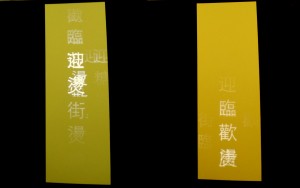Claiming space: Transgressions/ Cantosphere
Between East Georgia and Main St, located on the periphery of Chinatown, Centre A is currently exhibiting Transgression/ Cantosphere. The exhibit was conceived as a collaboration between the linguist Zoe Lam, artist Howie Tsui and the art company Hong Kong Exile (HKX) in regards to concerns about the 2012 Guangdong language regulations and the 2014 Occupy Central protests, and the relevance of those events to losses of culture faced by Vancouver’s Yuht communities in Chinatown.
Physical orientation is important. Entering the gallery, there’s a table with a mahjong game set up, and four headphones echoing with voices teaching and learning Cantonese. Along one side is a brochure explaining the exhibit themes, and a single sheet with translations. On the opposite wall, is a painted run-on-sentence, leading the visitor into the next room.
Walk into the next room and it’s intimidatingly dark. The only light flickers between yellow and white, and comes from projected sign that flashes a variation of ten phrases on repeat. A recording pairs a voice with the phrases.
Immersed in the dark, all a ttention is focused on the sign and the sounds. Each word is spoken by a single voice, then a chorus of voices chime in and echo the entire phrase. As one phrase transitions into another, the cacophony of sound fades into a single voice and the cycle is repeated over and over, with the chorus becoming increasingly louder as the last two phrases appear, finally ending on a last phrase, a message about hope in questioning.
ttention is focused on the sign and the sounds. Each word is spoken by a single voice, then a chorus of voices chime in and echo the entire phrase. As one phrase transitions into another, the cacophony of sound fades into a single voice and the cycle is repeated over and over, with the chorus becoming increasingly louder as the last two phrases appear, finally ending on a last phrase, a message about hope in questioning.
Considering the significance of the yellow and black colour scheme in Hong Kong’s Occupy Central protests, the colours of the lighting choice in the room place emphasis on the historical and physical locations associated with the projected phrases –such as the phrase “Hong Kong
is a shopping paradise”referring the history of Hong Kong’s development into a port city under British rule. These colours also represent Yuht culture, and via the projected text, establish a direct link between culture and language by making the text the only thing visible in the dark room.
As someone who doesn’t understand the language, distinguishing between tonal subtleties is hard; trying to read the translation sheet in the dark is even more difficult. It takes careful listening and reading to understand the differences in tone and the invocations of particular places and histories, like the reference to the slogan of reviving the Ming Empire. Even with the translation, there remains a gap in cultural understanding — a different kind of viewing experience dependant on whether or not someone understands the language projected.
Language, as a social construct, is so tightly linked with culture such that loss of language is equated to loss of culture. In this space dedicated to culture and language, understanding of the exhibit is limited by understanding of the language. If the question is: if Yuht culture is under threat in Vancouver, at the least, this gallery space has been successfully reclaimed.
